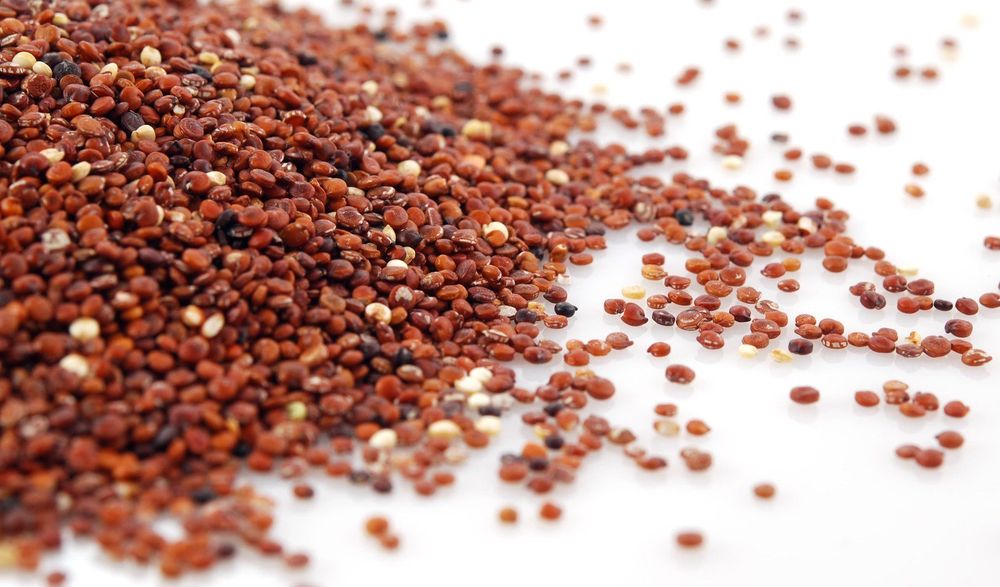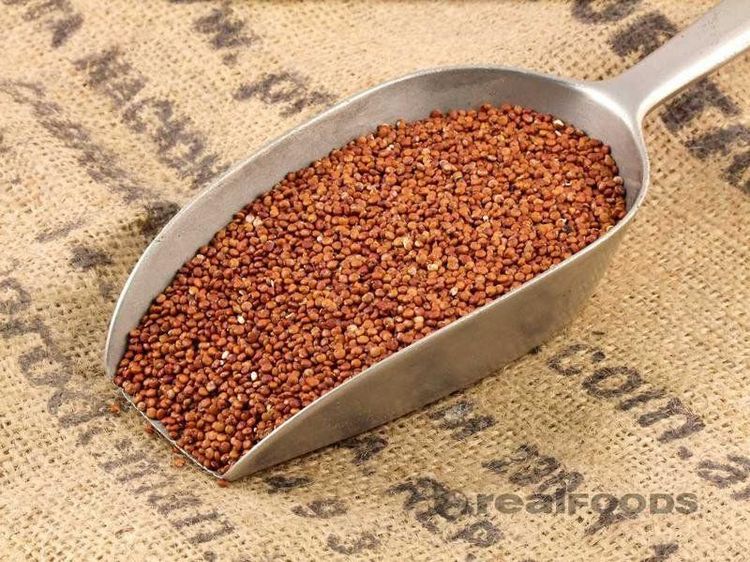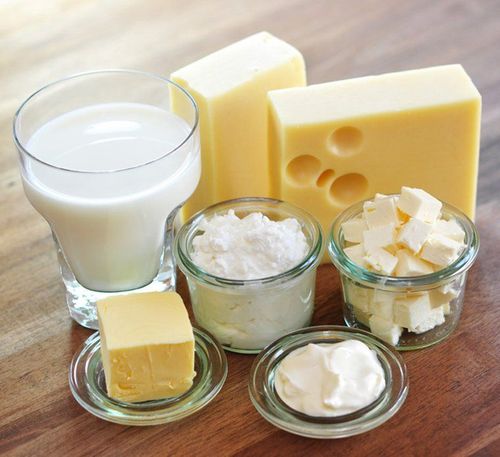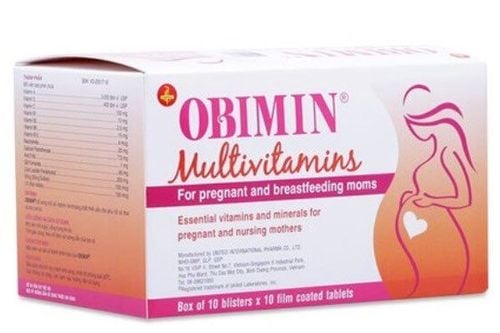Quinoa has been used for over 5,000 years and is still popular today because of its impressive flavor and impressive nutritional composition. Organic quinoa is high in fiber, vitamins, minerals, and antioxidants, is an excellent source of protein, and is gluten-free. Quinoa is not only nutritious, but it also has a variety of colors, each color with subtle differences in flavor, texture, and nutritional content. Red quinoa is a great choice.
1. What is Red Quinoa?
Red quinoa comes from the flowering plant called Chenopodium quinoa in South America. Uncooked, red quinoa is oval, flat, and crunchy. Once cooked, it swells into small spheres with a soft but chewy texture. Although called red quinoa, these seeds can sometimes be more brown or purple.
Quinoa is often considered a whole grain but is actually a pseudocereal because Quinoa does not grow on grass like wheat, oats, and barley. However, red quinoa and quinoa in general are eaten and prepared in the same way as traditional cereal grains. Red quinoa is also naturally gluten-free, so it is a healthy choice for people with Celiac disease or gluten sensitivity.
2. Nutritional value of Red Quinoa
Red quinoa is a highly nutritious pseudocereal, containing lots of fiber, protein, vitamins, and important minerals. In addition, red quinoa is also a rich source of manganese, copper, phosphorus, and magnesium. An estimated one cup of cooked red quinoa (about 185 grams) provides:
- Calories: 222 calories
- Protein: 8 grams
- Carbs: 40 grams
- Fiber: 5 grams
- Sugar: 2 grams
- Fat: 4 grams
- Manganese: 51% of the Daily Value (DV)
- Copper: 40% of the DV
- Phosphorus: 40% of the DV
- Magnesium: 28% of the DV
- Folate: 19% of the DV
- Zinc: 18% of the DV
- Iron: 15% of the DV
The same serving size also provides more than 10% of the daily requirement for B vitamins (including Thiamine, Riboflavin, and Pyridoxine), all of which are essential for brain function and metabolism. Notably, red quinoa is also higher in protein than other grains such as wheat, rice, and barley. In fact, it is one of the few plant foods that contains all nine essential amino acids, including Lysine, which most grains do not contain.

3. Health Benefits of Red Quinoa
Currently, there are few studies specifically evaluating the health benefits of red Quinoa. Most of the current studies only evaluate the benefits of the ingredients in it, as well as Quinoa in general.
3.1. Rich in antioxidants
In a study on the antioxidant properties of 4 colors of quinoa such as white, yellow, red-purple, and black, red quinoa was evaluated to have the highest antioxidant activity. It is especially rich in flavonoids, which are plant compounds with antioxidant, anti-inflammatory and anti-cancer properties. In fact, one study observed that cooked red quinoa had significantly higher levels of total polyphenols, flavonoids, and overall antioxidant activity than cooked yellow quinoa.
Red quinoa is particularly high in two flavonoids:
- Kaempferol. This antioxidant has been shown to reduce the risk of chronic diseases, including heart disease and some cancers.
- Quercetin. This antioxidant may protect people against serious conditions such as Parkinson's disease, heart disease, osteoporosis, and some cancers.
In addition, red quinoa contains plant pigments with antioxidant properties, such as betaxanthin (yellow) and betacyanins (purple), both of which are betalain pigments. Betalains have been shown in test tubes to have powerful antioxidant effects, protecting DNA against oxidative damage and reducing the risk of cancer. However, studies in humans are needed to confirm these effects.
3.2. Reducing Heart Disease Risk
The betalain pigments in red quinoa may also play an important role in the health of the heart. In one study, feeding diabetic rats 91 and 182 grams of betalain extract per pound (200 and 400 grams per kg) of body weight, respectively, significantly reduced their triglycerides, as well as their total cholesterol and LDL cholesterol (bad), while increasing their HDL cholesterol (good).
Red quinoa may have heart-healthy benefits and is considered a whole grain. Several big studies have also linked whole-grain consumption to a reduced risk of heart disease, cancer, obesity, and death from all causes.

3.3. High in Fiber
Red quinoa is high in fiber, with just one cup of 185 grams of cooked red quinoa providing 24% of the daily value for fiber. Diets high in fiber are also strongly linked to a reduced risk of heart disease, some cancers, type 2 diabetes, obesity, and death from many causes.
Red quinoa contains both insoluble and soluble fiber, which each provide unique benefits to the body:
- Soluble fiber absorbs water and turns into a gel-like substance during digestion, thereby increasing feelings of fullness. It can also improve heart health by lowering total cholesterol and LDL cholesterol (bad).
- Insoluble fiber helps maintain intestinal tract health and plays an important role in preventing type 2 diabetes.
3.4. Nutritious and Gluten-Free
Because it is a pseudocereal, red quinoa does not contain gluten, which is commonly found in traditional cereal grains such as wheat, barley, and rye. Therefore, it is an extremely healthy choice for people with celiac disease or gluten intolerance.
Quinoa is generally a good source of fiber and contains many important minerals. Adding red quinoa to your diet can significantly improve your overall nutritional intake if you are following a gluten-free diet.
3.5. Methods to Incorporate Red Quinoa into Diet
Red quinoa typically has a stronger, more grainy flavor than regular white grains. Here are some suggestions for incorporating red quinoa into daily diets:
- Cook red quinoa instead of rice.
- Mix it with vegetables to make salads.
- Cook quinoa porridge for breakfast.
- Sprinkle quinoa into salads and smoothies for decoration and extra protein.
As with other quinoa varieties, rinse red quinoa before cooking to remove the bitter coating, also known as saponins. Moreover, rinsing quinoa also helps reduce plant compounds called phytates and oxalates. These can bind certain minerals, making it harder for your body to absorb.

Red quinoa is prepared similarly to other grains. Simply simmer in liquid form in a 2:1 ratio, for every 1 cup (170 grams) of raw quinoa, combine with 2 cups (473 ml) of liquid.
Red quinoa is rich in protein, fiber, and many important vitamins and minerals. In addition, it has a higher antioxidant content than other types of quinoa, providing certain benefits for cardiovascular health. Therefore, you can consider adding a portion of red quinoa to your family's daily meals.
Reference source: healthline.com
To arrange an appointment, please call HOTLINE or make your reservation directly HERE. You may also download the MyVinmec app to schedule appointments faster and manage your reservations more conveniently.








